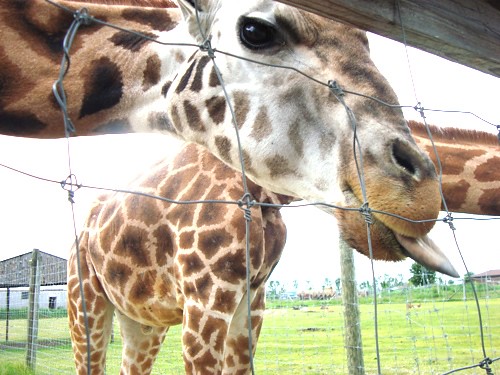You are here
Trip to Elmvale Zoo
On Friday, Margaret and I took our boys to Elmvale zoo, located just 15 minutes north of Barrie. Elmvale zoo isn't particularly grand in scale, but they care for animals from just about every continent, save Antarctica.
Here are some flamingos busy feeding themselves with their heads upside down:
Flamingos feed upside down because their beaks are shaped to filter food from mud and other non-edibles while their heads are inverted.
In the wild, flamingos typically feed on blue-green algae and shrimp - both are abundant in beta-carotene, which is what gives them their orange color.
Flamingos that live in zoos are typically given food that is mixed with an additive called canthaxanthin - this is the same carotenoid pigment that is used to impart an orange tinge to factory farmed salmon.
Though our boys seemed to enjoy watching every animal we encountered, they were clearly most impressed by a family of giraffes. Here's one that wasn't shy about flexing its gloriously long neck and asking us for some good eats:
Speaking of the giraffe's neck, I was surprised to learn that giraffes only have seven vertebrae in their neck column, the same as us humans.
Here are a few other interesting facts that you may not know about the world's tallest living animal:
-
Giraffes can run as fast as 35 miles (56 km) an hour.
-
At top speed, they can outrun a horse with ease.
-
No two giraffes have the same pattern, but all have larger spots on their bodies than they do on their heads and legs.
Fully developed giraffes are between 14 and 19 feet tall, and weigh between 1,750 and 2,800 pounds. Talk about gentle giants!
Well, a bit off topic from our usually healthy eating and living fare, but hey, who doesn't like learning about other living creatures?
Join more than 80,000 readers worldwide who receive Dr. Ben Kim's free newsletter
Receive simple suggestions to measurably improve your health and mobility, plus alerts on specials and giveaways at our catalogue
Please Rate This
Highest Rated | Related Posts | ||













Comments
trip to Elmvale Zoo
Hello Dr. Kim,
I thoroughly enjoyed your post about your trip. Thank you very much.
Once I took my then 1 year old youngest boy to a small zoo where they have giraffes as well and I never forget the look on his face. He was sitting in his pushchair and the expression was very clearly 'what a tall animal!' -One of those priceless moments.
Just yesterday we as a family were discussing which animal has the longest neck in relation to it's body. Interestingly the flamingo came up, or could it be the swan? Also, how many vertebrae do those birds have? We still would like to find out.
I might be able to find the answers on google and let you know.
Cheers, Liz
Thanks for sharing Liz.
Thanks for sharing Liz. Priceless indeed. It feels good to know that we're not the only family that sits around and thinks about how many vertebrae different animals have. :)
Giraffes
FYI, I also heard from a docent at our local zoo (Reid Park Zoo in Tucson) that the dark colored pigment of giraffes tongues is an evolutionary adaptation to protect their tongues from the constant exposure to sun. Yes, a physiological sun block of sorts to protect them from sunburn! Brilliant, huh? I wonder if we'll all look like the Blue Man group in a few hundred years.
wow
That IS brilliant. The Blue Man group thing is a bit over my head, but Google will help me figure it out. :) Thanks for sharing.
Zoo
Hi
Thanks for sharing the info.I didn't realize they could out run a horse, they look so akward when running.
I was amazed when visiting our local zoo here in Pensacola, Fl that the giraffe's tongues are black.
Friend
MaryEllen
zoo and earthlings
i used to love zoos. until i saw the documentory earthlings. which was i think also recommended by dr. ben.
i still love animals but don't like to see animals in cages.
but otherwise i love dr ben articles.